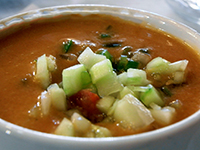 |
Gazpacho Soup |
Gazpacho is a soup made of raw vegetables and served cold. Modern gazpacho is typical of Spanish cuisine, originating from the southern region of Andalusia. But the dish has ancient roots. One theory is that it arrived in Spain and Portugal with the Romans as a soup of bread, olive oil, water, vinegar and garlic. However, to understand how this Roman dish evolved into the modern gazpacho we eat today requires the understanding of modern Spanish history. To understand the source of the modern gazpacho one needs to understand how its essential ingredients, the tomato, the cucumber, and the chile pepper made it to Spain.
 |
 |
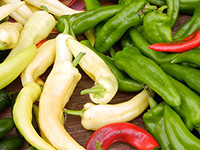 |
The rest of the ingredients of the modern gazpacho (olive oil, garlic, and bread) are typical Mediterranean ingredients that have been in use in the mainland since the time of the Roman Empire.
In Spain, gazpacho became a part of Andalusian cuisine, particularly Córdoba and Seville, using stale bread, garlic, olive oil, salt, and vinegar. During the 19th century, the red gazpacho evolved when tomatoes were added. This is the version that spread internationally. There are many modern variations of gazpacho, often in different colors with and without tomatoes and bread. Beside cucumbers, they may include avocados, and even watermelon or grapes.
Within Andalusia, eventually every region developed its own variety of gazpacho. They are of the red variety (containing tomato), white (no tomato, but including dried fruits), and green (white gazpacho containing spices making them green). However, all these regional variations have their basic ingredients in common: garlic paste which works as an emulsifier, bread, olive oil, vinegar and salt.
 Arranque roteño. |
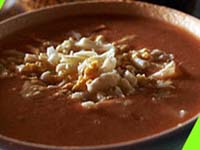 Gazpacho extremeño. |
Gazpacho manchego only shares its name with the cold gazpacho soup. It is mainly a game meat stew eaten with bread cakes. The only relation between the two is the the use of bread. While gazpacho is original from Andalusia, Gazpachos Manchegos originates in La Mancha, a region on the elevated plateau in central Spain. It is cooked in a cauldron and served hot.
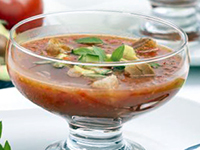 Mexican gazpacho. |
 Gazpacho Moreliano. |
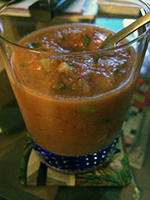 American Gazpacho from the NYT. |
Ingredients:
- 2 lbs ripe red tomatoes, cored and roughly cut into chunks
- 1 Italian frying (cubanelle) pepper or another long, light green pepper, such as Anaheim, cored, seeded and roughly cut into chunks
- 1 cucumber, about 8 inches long, peeled and roughly cut into chunks
- 1 small mild onion (white or red), peeled and roughly cut into chunks
- 1 clove garlic
- 2 tsp sherry vinegar, more to taste
- Salt
- 1/2 cup extra-virgin olive oil, more to taste, plus more for drizzling
Preparation:
- Combine tomatoes, pepper, cucumber, onion and garlic in a blender or, if using a hand blender, in a deep bowl. If necessary, work in batches. Blend at high speed until very smooth, at least 2 minutes, pausing occasionally to scrape down the sides with a rubber spatula.
- With the motor running, add the vinegar and 2 teaspoons salt. Slowly drizzle in the olive oil. The mixture will turn bright orange or dark pink and become smooth and emulsified, like a salad dressing. If it still seems watery, drizzle in more olive oil until texture is creamy.
- Strain the mixture through a strainer or a food mill, pushing all the liquid through with a spatula or the back of a ladle. Discard the solids. Transfer to a large pitcher (preferably glass) and chill until very cold, at least 6 hours or overnight.
- Before serving, adjust the seasonings with salt and vinegar. If soup is very thick, stir in a few tablespoons ice water. Serve in glasses, over ice if desired. A few drops of olive oil on top are a nice touch.
back to Radim and Lisa's Well-Travelled Cookbook | email us
Last updated: February 11, 2017
Some photographs from Wikimedia Commons are used under the terms of the GNU Free Documentation License.